Abstract
Of 269 consecutive patients entered into a preoperative assessment programme for possible surgical treatment of epilepsy, 33 had intracranial recording (SEEG) with combined subdural and depth electrodes for the purpose of localising a suspected temporal site of seizure onset. The findings in these patients are analysed with particular reference to: 1) the criteria of selection for SEEG and their validity; 2) information on SEEG compared with that obtained by less invasive means, including foramen ovale telemetry; 3) information on the use of intracerebral electrodes compared with subdural placements; 4) possible predictors of failure of localisation by SEEG and of surgical outcome. It was concluded that SEEG had usefully contributed to the management of 69% of the patients in whom it was used, establishing a previously unidentified site of seizure onset in 33%, correcting an erroneous localisation in 15%, and establishing inoperability in 21% of patients. No predictors of failure of SEEG or of surgery emerged; thus there was no evidence of unnecessary use of this procedure. Five patients were found with incorrect lateralisation of seizure onset on foramen ovale recording (of a total of 192 foramen ovale telemetries). Localisation of the ictal onset zone either by the distribution of inter-ictal discharges or by the initial ictal changes at subdural electrodes was unreliable, confirming the need for ictal, depth recordings.
Full text
PDF
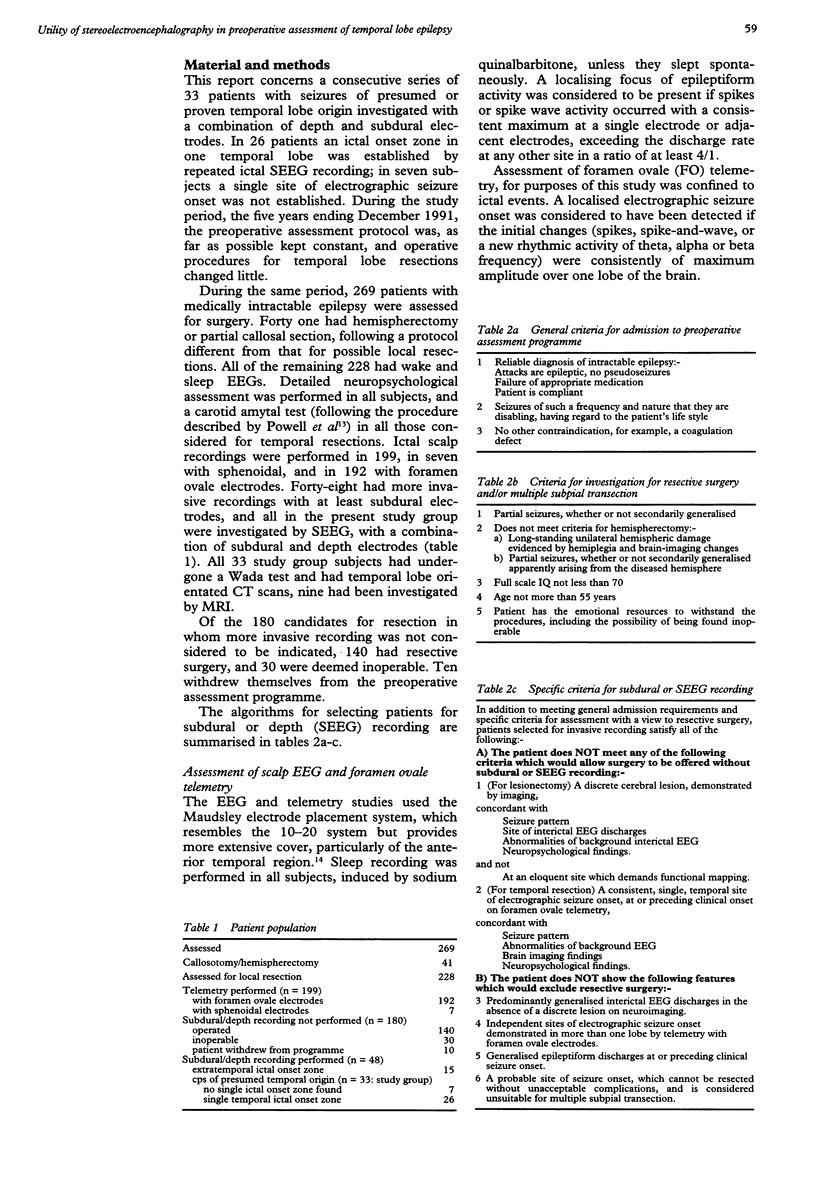

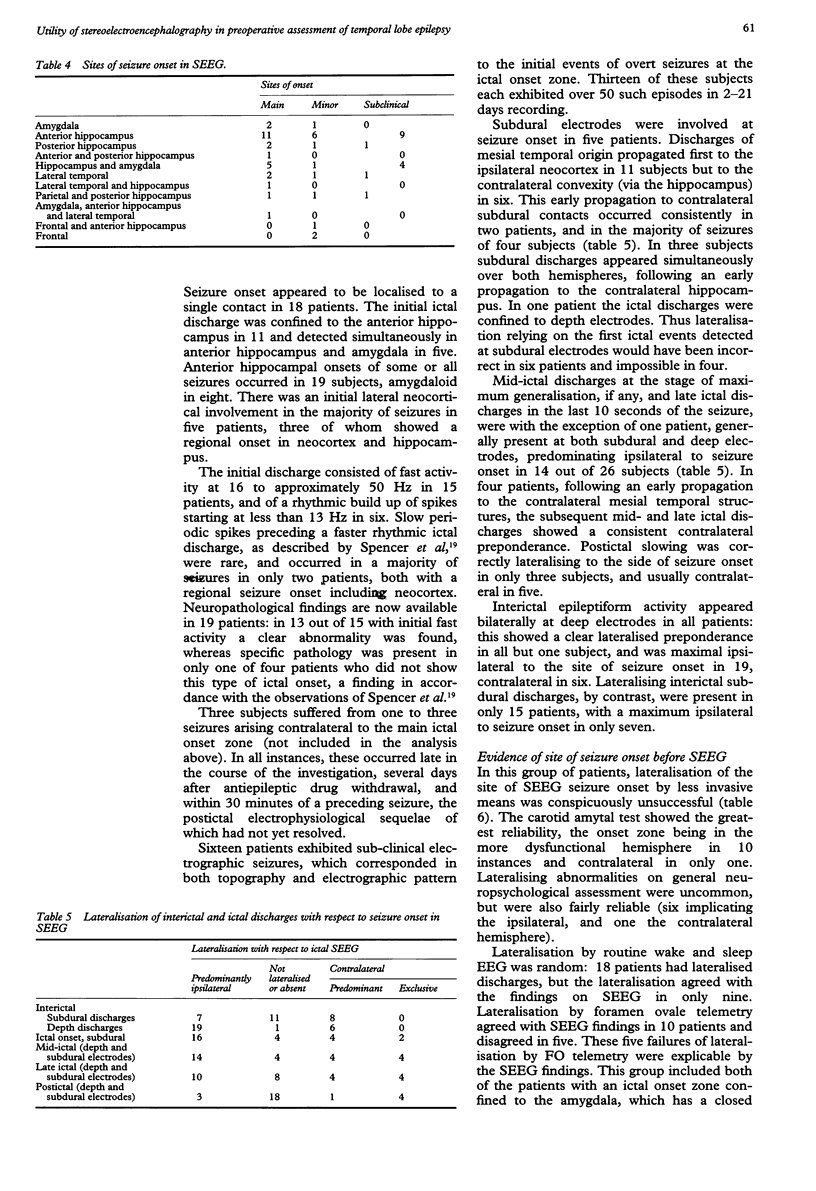
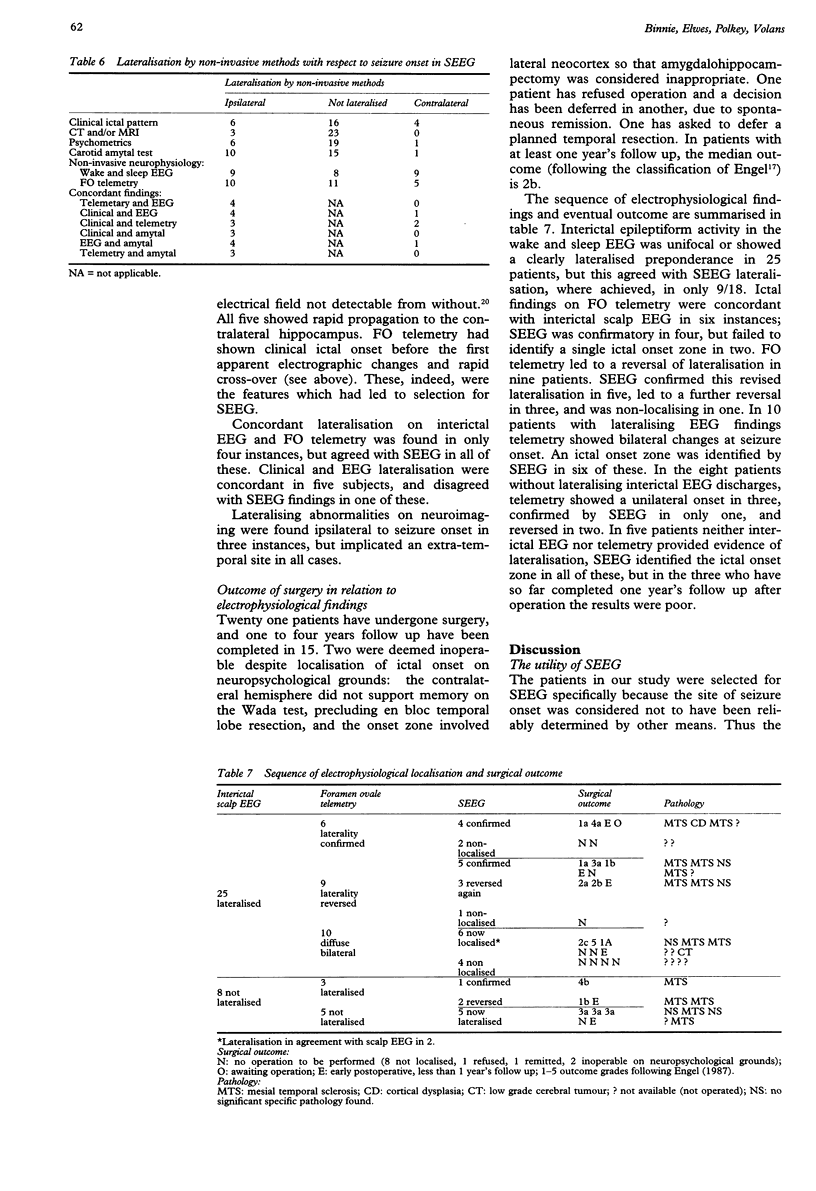
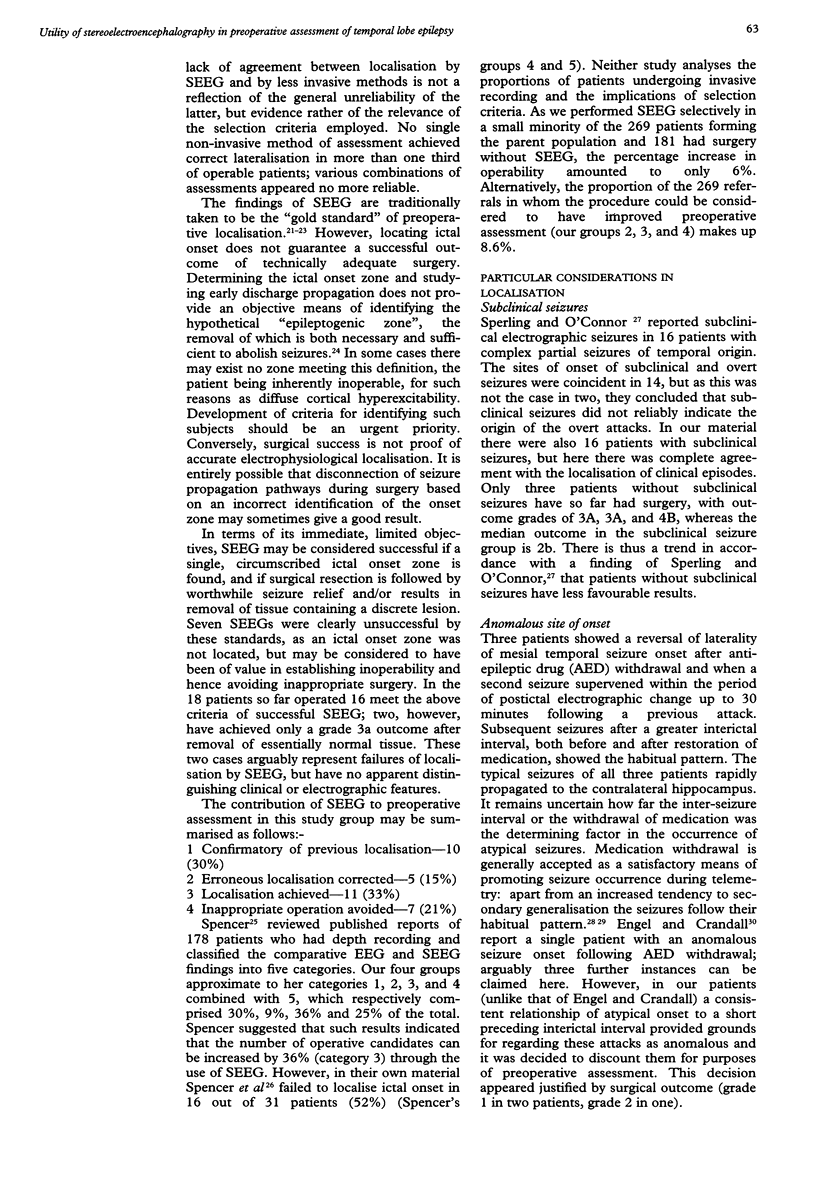
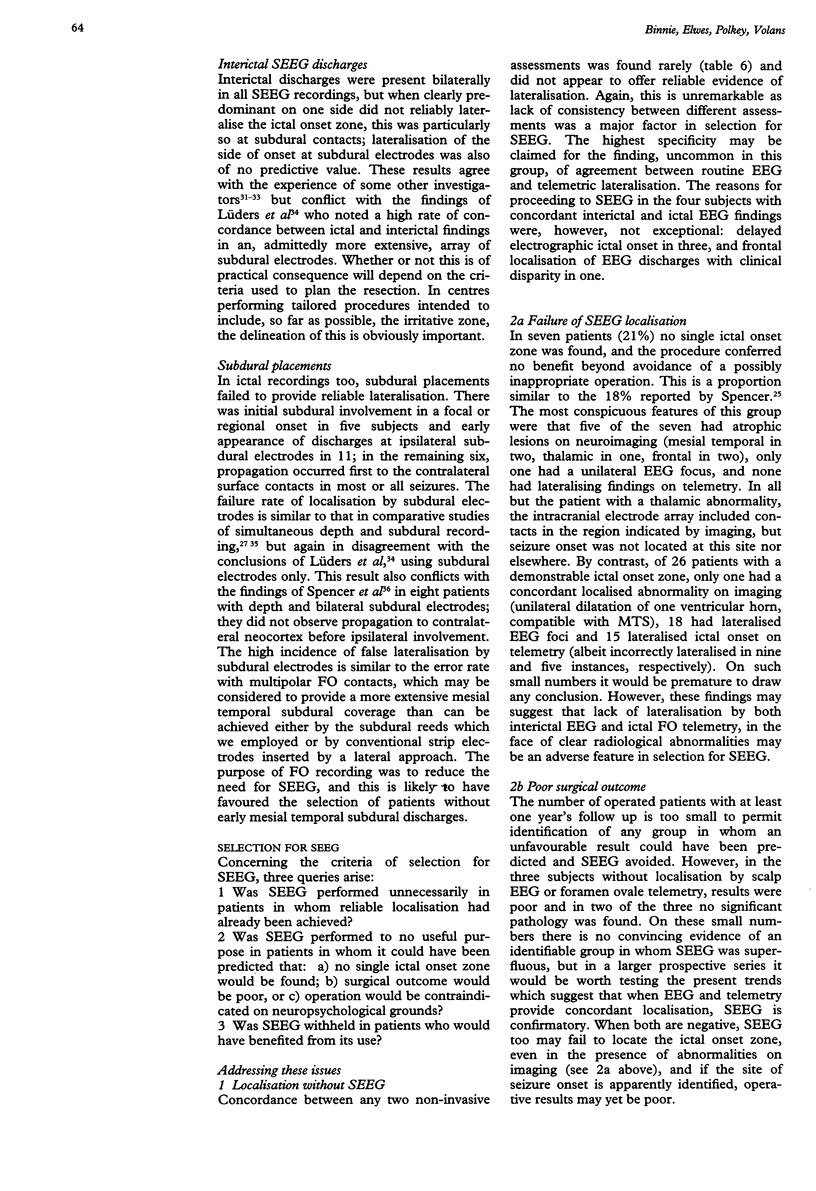

Selected References
These references are in PubMed. This may not be the complete list of references from this article.
- Agbi C., Polkey C. E. Calculation of coordinates for depth electrodes placed in temporal lobe structures visualized by oblique CT scan cuts. Br J Neurosurg. 1990;4(6):517–521. doi: 10.3109/02688699008993802. [DOI] [PubMed] [Google Scholar]
- BLOOM D., JASPER H., RASMUSSEN T. Surgical therapy in patients with temporal lobe seizures and bilateral EEG abnormality. Epilepsia. 1960 Jun;1:351–365. doi: 10.1111/j.1528-1157.1959.tb04272.x. [DOI] [PubMed] [Google Scholar]
- Davidson S., Falconer M. A. Outcome of surgery in 40 children with temporal-lobe epilepsy. Lancet. 1975 Jun 7;1(7919):1260–1263. doi: 10.1016/s0140-6736(75)92549-0. [DOI] [PubMed] [Google Scholar]
- Delgado-Escueta A. V., Walsh G. O. The selection process for surgery of intractable complex partial seizures: surface EEG and depth electrography. Res Publ Assoc Res Nerv Ment Dis. 1983;61:295–326. [PubMed] [Google Scholar]
- Engel J., Jr, Crandall P. H. Falsely localizing ictal onsets with depth EEG telemetry during anticonvulsant withdrawal. Epilepsia. 1983 Jun;24(3):344–355. doi: 10.1111/j.1528-1157.1983.tb04898.x. [DOI] [PubMed] [Google Scholar]
- Engel J., Jr, Rausch R., Lieb J. P., Kuhl D. E., Crandall P. H. Correlation of criteria used for localizing epileptic foci in patients considered for surgical therapy of epilepsy. Ann Neurol. 1981 Mar;9(3):215–224. doi: 10.1002/ana.410090303. [DOI] [PubMed] [Google Scholar]
- Gloor P. Contributions of electroencephalography and electrocorticography to the neurosurgical treatment of the epilepsies. Adv Neurol. 1975;8:59–105. [PubMed] [Google Scholar]
- Gotman J. Automatic recognition of epileptic seizures in the EEG. Electroencephalogr Clin Neurophysiol. 1982 Nov;54(5):530–540. doi: 10.1016/0013-4694(82)90038-4. [DOI] [PubMed] [Google Scholar]
- Lieb J. P., Engel J., Jr, Gevins A., Crandal P. H. Surface and deep EEG correlates of surgical outcome in temporal lobe epilepsy. Epilepsia. 1981 Oct;22(5):515–538. doi: 10.1111/j.1528-1157.1981.tb04124.x. [DOI] [PubMed] [Google Scholar]
- Lieb J. P., Joseph J. P., Engel J., Jr, Walker J., Crandall P. H. Sleep state and seizure foci related to depth spike activity in patients with temporal lobe epilepsy. Electroencephalogr Clin Neurophysiol. 1980 Sep;49(5-6):538–557. doi: 10.1016/0013-4694(80)90396-x. [DOI] [PubMed] [Google Scholar]
- Lüders H., Hahn J., Lesser R. P., Dinner D. S., Morris H. H., 3rd, Wyllie E., Friedman L., Friedman D., Skipper G. Basal temporal subdural electrodes in the evaluation of patients with intractable epilepsy. Epilepsia. 1989 Mar-Apr;30(2):131–142. doi: 10.1111/j.1528-1157.1989.tb05445.x. [DOI] [PubMed] [Google Scholar]
- Marciani M. G., Gotman J., Andermann F., Olivier A. Patterns of seizure activation after withdrawal of antiepileptic medication. Neurology. 1985 Nov;35(11):1537–1543. doi: 10.1212/wnl.35.11.1537. [DOI] [PubMed] [Google Scholar]
- Margerison J. H., Binnie C. D., McCaul I. R. Electroencephalographic signs employed in the location of ruptured intracranial arterial aneurysms. Electroencephalogr Clin Neurophysiol. 1970 Mar;28(3):296–306. doi: 10.1016/0013-4694(70)90166-5. [DOI] [PubMed] [Google Scholar]
- Morris H. H., 3rd, Kanner A., Lüders H., Murphy D., Dinner D. S., Wyllie E., Kotagal P. Can sharp waves localized at the sphenoidal electrode accurately identify a mesio-temporal epileptogenic focus? Epilepsia. 1989 Sep-Oct;30(5):532–539. doi: 10.1111/j.1528-1157.1989.tb05468.x. [DOI] [PubMed] [Google Scholar]
- Powell G. E., Polkey C. E., Canavan A. G. Lateralisation of memory functions in epileptic patients by use of the sodium amytal (Wada) technique. J Neurol Neurosurg Psychiatry. 1987 Jun;50(6):665–672. doi: 10.1136/jnnp.50.6.665. [DOI] [PMC free article] [PubMed] [Google Scholar]
- Spencer S. S. Depth electroencephalography in selection of refractory epilepsy for surgery. Ann Neurol. 1981 Mar;9(3):207–214. doi: 10.1002/ana.410090302. [DOI] [PubMed] [Google Scholar]
- Spencer S. S., Guimaraes P., Katz A., Kim J., Spencer D. Morphological patterns of seizures recorded intracranially. Epilepsia. 1992 May-Jun;33(3):537–545. doi: 10.1111/j.1528-1157.1992.tb01706.x. [DOI] [PubMed] [Google Scholar]
- Spencer S. S., Spencer D. D., Williamson P. D., Mattson R. H. Ictal effects of anticonvulsant medication withdrawal in epileptic patients. Epilepsia. 1981 Jun;22(3):297–307. doi: 10.1111/j.1528-1157.1981.tb04113.x. [DOI] [PubMed] [Google Scholar]
- Spencer S. S., Spencer D. D., Williamson P. D., Mattson R. H. The localizing value of depth electroencephalography in 32 patients with refractory epilepsy. Ann Neurol. 1982 Sep;12(3):248–253. doi: 10.1002/ana.410120306. [DOI] [PubMed] [Google Scholar]
- Spencer S. S., Williamson P. D., Bridgers S. L., Mattson R. H., Cicchetti D. V., Spencer D. D. Reliability and accuracy of localization by scalp ictal EEG. Neurology. 1985 Nov;35(11):1567–1575. doi: 10.1212/wnl.35.11.1567. [DOI] [PubMed] [Google Scholar]
- Sperling M. R., O'Connor M. J. Auras and subclinical seizures: characteristics and prognostic significance. Ann Neurol. 1990 Sep;28(3):320–328. doi: 10.1002/ana.410280304. [DOI] [PubMed] [Google Scholar]
- Walter R. D. Principles of clinical investigation of surgical candidates. Adv Neurol. 1975;8:49–58. [PubMed] [Google Scholar]
- Yaşargil M. G., Teddy P. J., Roth P. Selective amygdalo-hippocampectomy. Operative anatomy and surgical technique. Adv Tech Stand Neurosurg. 1985;12:93–123. doi: 10.1007/978-3-7091-7008-3_2. [DOI] [PubMed] [Google Scholar]
- van Veelen C. W., Debets R. M., van Huffelen A. C., van Emde Boas W., Binnie C. D., Storm van Leeuwen W., Velis D. N., van Dieren A. Combined use of subdural and intracerebral electrodes in preoperative evaluation of epilepsy. Neurosurgery. 1990 Jan;26(1):93–101. doi: 10.1097/00006123-199001000-00013. [DOI] [PubMed] [Google Scholar]


